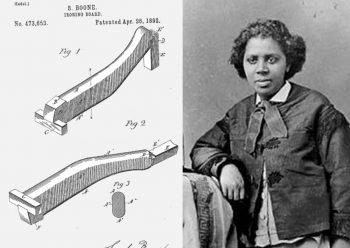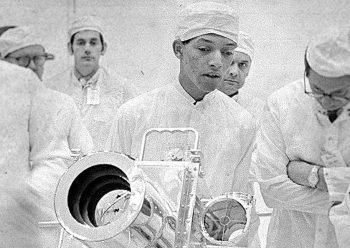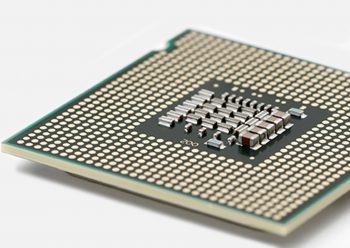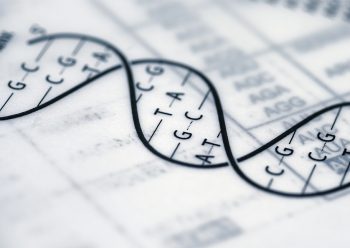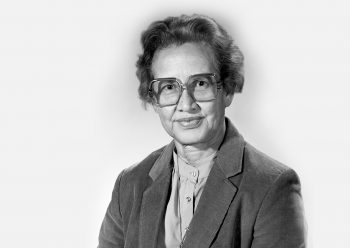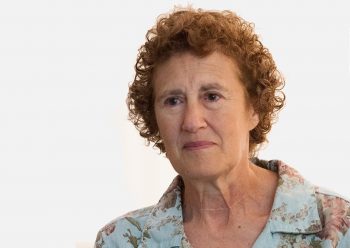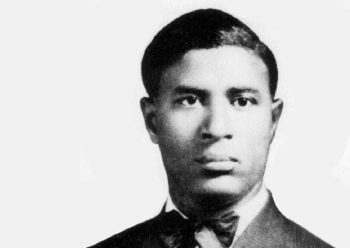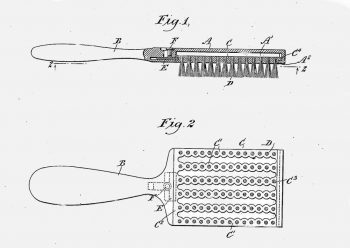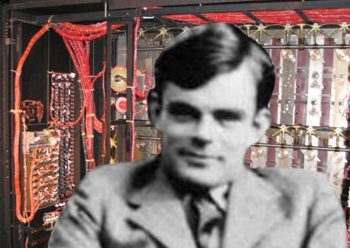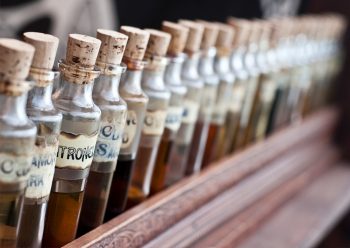Ironing board patent
Sarah Boone
Sarah Boone (1832-1904) is only one of four African-American women to have been granted a patent by the US Patent Office between 1865 (the end of the American Civil War) and 1900.
Sarah was born into slavery in North Carolina – an area where at the time it was illegal to teach a black person to read and write. Sarah married and moved to Connecticut and it is believed learnt to read and write in her forties.
Sarah was working as a dressmaker when she improved upon the design of the ironing board through the addition of hinged legs and a change to the width of the board that made it easier to iron sleeves.
She was granted a patent in 1892 by the state of Connecticut. Records show that the Boone’s owned their own house giving an indication of success.
Source material
Author
Jo Hodson
Head of Business Development
Inventor, engineer and space scientist
George Robert Carruthers
George Robert Carruthers (1939 - 2020) was a physicist and inventor who engineered the first moon-based observatory and worked to promote diversity, equality and inclusion in science. His work provided some of the greatest contributions to the US space program.
George Carruthers was born in 1939 in Cincinnati, Ohio, US. His father was a civil engineer and was the main person responsible for fostering George’s interest in science from a young age. When George was 10 years old he built his own telescope using cardboard tubing and lenses he ordered with money he earned delivering newspapers.
After finishing school in 1957, George studied Physics at the University of Illinois Urbana- Champaign, also earning a master’s in nuclear engineering (1962), and a PhD in Aeronautical and Astronautical engineering (1964) from the same university.
In 1965, he began working at the U.S. Naval Research Laboratory in Washington (NRL), D.C. and four years later he was awarded a patent for his “Image Converter for Detecting Electromagnetic Radiation Especially in Short Wave Lengths.”
During his tenure at the NRL, George extended his previous research, focusing on the far ultraviolet, and developing a device to analyse and illuminate ultraviolet radiation. His new device allowed for the detection and measurement of elements in their unexcited state and resulted in the development of a Far Ultraviolet Camera/Spectrograph.
George’s spectrograph was used during a rocket flight in 1970 and detected the existence of molecular hydrogen in interstellar space. This discovery, received international acclaim, and filled a substantial gap in understanding of the interstellar medium, providing a framework for explaining how stars form.
In 1972, George’s spectrograph was used on the NASA’s Apollo 16 mission to the moon, allowing for the study of UV images of hundreds of stars. In addition, his invention provided, for the first time, a visual indication of the concentration and effect of pollutants on the Earth’s atmosphere. The images obtained with George’s Far Ultraviolet lunar spectrograph were also instrumental for global space-weather forecasting.
George’s endeavours extended to education, in particular in the field of science. In the 1980’s George created an apprenticeship program to allow school students to participate in summer internships working with scientists at the Naval Research Laboratory. He also helped support several science education initiatives, and taught a course in Earth and Space Science at Howard University.
In his contribution to education, George worked to change the reality of minorities in Science, campaigning for equality in academia and industry.
Throughout his life, George was responsible for a series of inventions which significantly contributed to the understanding of the compositions of interstellar gas and planetary atmospheres, and which were recognised by a series of awards, including with him being inducted into the National Inventors Hall of Fame in 2003 and being awarded the National Medal of Technology and Innovation in 2012. George died on 26 December 2020.
The legacy of George’s work in Physics, Astronomy and Education continues today, inspiring young people and paving the way to new discoveries.
References
- https://blackinventor.com/george-carruthers
- https://www.nasa.gov/looking-back-dr-george-carruthers-and-apollo-16-far-ultraviolet-cameraspectrograph
- https://www.blackpast.org/african-american-history/george-carruthers-1939/
- https://archive.nsbp.org/nsbp-news/bhm-physics-profiles/2017-honorees/30-george-carruthers
- https://www.nature.com/articles/d41586-021-00461-w
Microelectronics chip
Lynn Conway
Lynn Conway, born 1938, is a world-renowned inventor of microelectronics chip design. Now in her ninth decade, she has led a fascinating life achieving successes in the field of science and computing that for most are simply unimaginable. Lynn was born into a male body, and for most of her life, she has battled against discrimination, both before and after her transition from male to female in the late 1960s.
Conway dropped out of MIT in 1959, months before graduating, falling into depression after being denied access to hormone treatment. It would be two years before she returned to education, earning both a bachelors and masters degree from Columbia University. After graduating, and still living as a man, Lynn started work at IBM. It was here that in 1965 she devised the ground breaking Dynamic Instruction Scheduling (DIS) enabling computers to issue multiple out-of-order instructions per machine cycle in supercomputers and thus enabling the birth of superscalar computers.
In 1967, ten years on from her first attempt at asking for help, science had moved on and pioneering sex change surgery had become a possibility. Lynn decided to try again and informed her employers that she would be transitioning from male to female. Company management was shocked by her plans to transition and she was sacked a few months before her gender transition surgery. The sacking was just the beginning of the discrimination Lynn would face. As a man, Lynn had married and fathered two children; transitioning meant that she was blocked from seeing them for the next 14 years. She also found it difficult to get a new job – each time a background check was completed, job offers were rescinded or employers would refuse to take things further.
Eventually, she was offered a role at Computer Applications, Inc. (CAI) and then at a small computer company (Memorox) where she worked on computer architecture. From here, she moved to Xerox and worked in the renowned Palo Alto Research Centre where she pioneered the design of Very Large Scale Integration (VLSI) – a technology that enabled modern chips like the Pentium chip.
Despite becoming well known for her work on VLSI and continuing her research work (for which she has been named as an inventor on five patents), throughout this period, Lynn lived in what she terms ‘stealth’ mode, with very few people knowing anything of her background. She lived fearful that exposure would mean a loss of civil rights and a loss of employment. She even spent a semester teaching a VLSI course at MIT without disclosing that she had been a former student.
It was only in the late 90s that Conway felt able to open up about her background. Lynn is Professor of Electrical Engineering & Computer Science, Emerita, at the University of Michigan, Ann Arbor. Today Lynn supports young people with gender identity dysphoria (GID) through her website.
Source material
Author
Bénédicte Moulin
Partner, Patent Attorney
Double helix structure of DNA
Rosalind Franklin
2020 marks the centenary of the birth of Rosalind Franklin (1920-1958). Rosalind Franklin was a British chemist who made a significant contribution to the elucidation of the double helix structure of DNA along with Nobel Prize winners, Maurice Wilkins, James Watson and Francis Crick.
Rosalind was born in London and studied natural sciences at Cambridge University. Although Rosalind was born into a wealthy and educated family, at that time it was still highly unusual and difficult for a woman to study chemistry. After graduating, she worked as a research chemist in the British Coal Utilisation Research Association, with her studies on the molecular structure of coal earning her a PhD from Cambridge in 1945. After the war, she found a job in Paris where she became adept at analysing carbon using X-ray crystallography. X-ray crystallography is a tool used for determining the atomic and molecular structure of a crystal. The crystalline atoms cause a beam of X-rays to diffract into many specific directions, producing a diffraction pattern or photograph. Detailed analysis of this pattern can then be used to determine the 3D structure of the crystallised molecule.
Rosalind subsequently moved to the Biophysical Laboratory at King’s College London, and developed new X-ray crystallography methodologies to investigate the structure of deoxyribonucleic acid (DNA). Maurice Wilkins was also working at King’s at that time, and accounts suggest that Maurice and Rosalind had a difficult working relationship. In 1952, Franklin obtained an X-ray diffraction pattern of DNA, and it is thought that Wilkins shared this photograph with James Watson and Francis Crick without Rosalind’s knowledge. In addition, Max Perutz is alleged to have shared a report including Rosalind’s detailed notes on the X-ray analysis with the team.
This X-ray diffraction pattern was a vital piece of evidence used by Watson and Crick to solve the double helix structure of DNA, paving the way for a revolution in biology and the development of the sophisticated recombinant technologies we take for granted today.
It is less well known that Rosalind also carried out a significant body of work on the structure of viruses. After a move to Birkbeck College, Rosalind’s research group used X-ray crystallography to probe the structure of a number of plant viruses, including the Tobacco Mosaic Virus, now perhaps one of the most well characterised viruses to date.
Despite a tragic death from ovarian cancer at the age of 37, Rosalind’s work was of fundamental importance, and her life serves as an inspiration to many female chemists and biologists to this day. In 1962, Watson, Crick and Wilkins were awarded the Nobel Prize in Physiology or Medicine for their work on the structure of nucleic acids. Since this was after Rosalind’s death, we will never know whether her contribution would have been recognised with a share of the prize (the Nobel Prize cannot be awarded posthumously). Given the environment for female scientists at the time, it seems unlikely that she would have been recognised by the Nobel committee. Thankfully, more recently Rosalind’s achievements have been publicised in many other ways. The Rosalind Franklin Institute dedicated to interdisciplinary life science research was established in 2018, and in 2022 the Rosalind Franklin rover will be sent to Mars to search for organic compounds on the Martian surface.
In 2020, over sixty years after Rosalind’s death, Emmanuelle Charpentier and Jennifer Doudna shared the Nobel Prize in Chemistry for their work on the CRISPR/Cas9 methodology for genome editing, the first time two women have shared the prize.
Sources
- https://www.chu.cam.ac.uk/archives/online-resources/rosalindfranklincentenary
- Rosalind Franklin: The Dark Lady of DNA, Brenda Maddox.
- https://www.newscientist.com/people/rosalind-franklin
Author
Catherine Keetch
Partner, Patent Attorney
World-renowned fashion designer
Tommy Hilfiger
As one of the world’s best known fashion designers Tommy Hilfiger’s labels can be found in high street stores almost everywhere allowing him to amass a huge personal wealth built around a hugely successful and iconic brand.
Born in 1952, the second of nine children growing up in a small city in New York, Hilfiger’s parents wanted him to get a college education and pursue a traditional career. He struggled at school with basic reading and writing due to his undiagnosed dyslexia. He is said to recall classmates calling him stupid. It wasn’t until later that he realised he was dyslexic.
At the age of 18 he started building his own company launching his menswear range in 1985, which later expanded into women’s clothing and a range of luxury items including perfume. In December 2005, Tommy Hilfiger sold the clothing brand for US$1.6 billion, to Apax Partners, a private investment company, who next sold it to Phillips-Van Heusen for US$3 billion. Hilfiger remains the company's principal designer, leading the design teams and overseeing the entire creative process. In 2012, Hilfiger was awarded the Geoffrey Beene Lifetime Achievement Award from the Council of Fashion Designers of America.
Dyslexia certainly didn't stop Hilfiger from achieving his goal to be a successful fashion designer. In fact he has since said that his inability to read well and feeling inferior in school was his inspiration for starting the luxury fashion brand. He still struggles with his dyslexia to some extent but actually credits it for his success and for making him stand out from the crowd.
Author
Richard Burton
Partner, Trade Mark Attorney
Enabling aerospace innovation
Katherine Johnson
Many people have their interest in science and innovation sparked during childhood when learning about the first missions to the moon. When we describe those events to children, the heroes of the story are men such as Neil Armstrong and Buzz Aldrin. However, in recent years, many efforts have been made to recognize the diverse group of individuals who contributed to these missions; Katherine Johnson was a trailblazer for women and in particular African-American women in the aerospace industry.
Katherine Johnson, nee Katherine Coleman, was born in 1918. From a young age, it was clear that Katherine was a highly talented mathematician, graduating school and college early and earning a bachelor’s degree in mathematics and French by the age of 18.
After college, Katherine took up a teaching job in Virginia before enrolling in a maths graduate program at West Virginia University. She studied maths there but soon left after marrying James Goble and deciding to start a family. He died in 1956, and three years later she married James Johnson.
In 1953 she began working at the National Advisory Committee for Aeronautics (NACA), a precursor of NASA. Katherine was part of the West Area Computing unit, a group of African American women who performed complex mathematical calculations for the program’s engineers. At a time before the availability of electronic computers, the women were called the “West Computers” – they were responsible for reading, analysing, and plotting complex data by hand. Despite carrying out highly technical and skilled work, this group of women were low paid in stark contrast to white male engineers. During this period, NACA was segregated and required Katherine and her colleagues to use separate work areas, bathrooms, and cafeterias to their white colleagues. It is very difficult to comprehend the challenges faced by an African-American woman in this male-dominated, white environment.
In 1958 NACA was incorporated into the newly formed National Aeronautics and Space Administration (NASA), which banned segregation. At NASA Johnson was a member of the Space Task Group. In 1960 she co-authored a research paper laying out the equations describing an orbital spaceflight in which the landing position of the spacecraft is specified. It was the first time a woman in her division was named as an author of a research report.
Johnson became an expert in geometry and spacecraft trajectories. She played an important role in NASA’s Mercury spaceflight program. In 1961 she calculated the flight path for Freedom 7, the spacecraft that put the first U.S astronaut in space, Alan B. Shepard, Jr. The following year, John Glenn, being aware of Katherine’s expertise, asked her to verify that the electronic computer had planned his flight trajectory correctly. Glenn subsequently became the first U.S. astronaut to orbit Earth aboard Friendship 7. Johnson was also part of the team that calculated trajectory and timings for the Apollo 11 mission, the first mission to send men to the moon. Johnson later worked on the space shuttle program. She retired from NASA in 1986. Katherine died on 24 February 2020.
Next time we look up at the moon with our awe-inspired children, maybe Katherine Johnson should get a mention as a hero in the story.
Source material
- https://www.nasa.gov/content/katherine-johnson-biography
- https://www.nytimes.com/2020/02/24/science/katherine-johnson-dead.html
- https://www.britannica.com/biography/Katherine-Johnson-mathematician
Author
Catherine Keetch
Partner, Patent Attorney
Computer scientist & winner of the Turing award
Barbara Liskov
Barbara Liskov is an acclaimed computer scientist and winner of several awards for her work on software programming, including the prestigious Turing award in 2008. She was one of a handful of women studying maths and computer science at university in the sixties and seventies, at a time when women were not given the same level of consideration and the same opportunities as men.
Barbara Liskov was born in 1939 in California and always had an interest in mathematics and science. While it might seem only natural that she would study mathematics at university (Berkeley, California), she was in fact one of only two women in her class of a hundred. After her BA in mathematics, she started working at Mitre Corporation in 1961 and started learning about software programming.
This would start her lifelong interest and dedication to designing programming languages. She realised that she was not only gifted in this technical area, she had a strong interest and wanted to help solve the problems that computers scientists were facing. As she wanted to learn more on the topic, she returned to academia and joined Stanford. Her PhD on a computer program to play chess was one of the first PhDs in the field of computer science to be awarded to a woman.
After her PhD, she went back to Mitre for a few years, working on designing and developing an experimental operating system “Venus” able to handle multiple users. She unknowingly started laying the foundation of her future work.
When she joined the Massachusetts Institute of Technology (MIT) in 1972, she was obsessed with addressing the problem of how to design programming languages and how to reconcile theoretical paper on the topic and practical needs and challenges. There seemed to be a barrier preventing this and she set out to overcome this barrier. She realised that some of her code design techniques used in the Venus project held the key to a new way of designing code. Around 1974-1975 and with a team of students, she created a new programming language “CLU” implementing these principles.
Amongst others things, she defined separate abstract data types or modules that defined components and functions associated with these components and specific rules that these modules should follow. This would provide a level of abstraction that would simplify the writing, maintenance and error handling of code. These principles are still widely used and relied on in modern object-oriented programming languages.
She has since then continued to contribute greatly to the field of computer science, for example working on programming language theory, distributed programs, object-oriented databases and distributed computing and a received a number of prestigious awards for her work.
While she managed to stand out thanks to the quality of her work, her career was still significantly affected by her gender and by the rules, perceptions and stereotypes that others associated with it. After her BA in mathematics, she applied to Princeton but at the time they did not accept female students in mathematics. While her fellow male students were given opportunities and recommendations for positions, she was not. Only later did she realise that some of the professors perpetuated what she called “the old boy network”, from which she was effectively excluded regardless of her accomplishments. As late as the nineties and early two-thousands, she found that the number of female recruits in her department demonstrated that women were still not being given the same consideration (the numbers increased when she became head of her department).
Author
Bénédicte Moulin
Partner, Patent Attorney
Inventor of the gas mask and traffic light system
Garrett Morgan
Garrett Morgan was a black American inventor and entrepreneur who possessed a keenly observant and caring nature. With it, he developed the gas mask and the traffic light system that keeps us safe on the road to this day.
Morgan was born in Kentucky in 1877; his parents were both freed slaves. Like many other black children growing up in the American Civil War’s aftermath, Morgan left home and school at a young age to find work. Working in Cincinnati as a handyman, he hired a tutor to continue his education. In 1895, Morgan left for Cleveland and found work as a sewing machine mechanic opening his own sewing machine shop in 1907, followed two years later by the opening of a tailoring shop.
While in his tailoring shop, Morgan noticed that sewing machine needles often scorched woollen materials due to friction. He developed a liquid polish for the needle to reduce this friction. However, after wiping away the liquid with a fur cloth, Morgan discovered that the cloth’s wavy fibres had become straight. Morgan tested this liquid on his hair, which too became straight. He developed the G. A. Morgan Hair Refining Cream, and set up the G. A. Morgan Refining Company in 1913 to manufacture and sell the product. The company became very successful, allowing Morgan to focus on other endeavours.
After seeing firefighters struggle to breathe while entering burning buildings, Morgan developed the “smoke hood” – now called the gas mask. The device comprised a wearable hood and a tube attached to the hood, which trailed to the ground. Hot smoke rises to the top of a room, leaving behind relatively cleaner air close to the ground. This cleaner air was drawn in through the tube, which had a filter, as the user inhaled. Morgan obtained two patents for this device in 1914, and founded the National Safety Device Company to manufacture and sell it. He even demonstrated the device to potential customers by sitting inside canvas tents filled with toxic smoke for up to 20 minutes. Being black, Morgan had to disguise himself as a Native American man while performing demonstrations to avoid dissuading potential customers.
National attention was drawn to the device during the Lake Erie Disaster of 1916; an explosion trapped 32 workers in a tunnel under the lake. Morgan and his brother donned the device, descended into the tunnel, and saved 20 workers, who would otherwise have suffocated from the smoke. This heroic act led to a surge in orders for the device, especially from fire departments. However, many orders were cancelled after it was discovered that Morgan was black.
Years later, Morgan witnessed a traffic accident at an intersection. He subsequently invented a traffic signal comprising a “T”-shaped sign mounted on a rotating vertical pole. When viewed from the front or back, the sign read “STOP”; when viewed from the left or right, the sign read “GO”. As the horizontal arms of the “T” were attached using hinges, they could be raised into a vertical position, resulting in the sign reading “STOP” in all directions; a life-saving feature that traffic signal systems then in use did not possess. The sign rotated by 90 degrees and the arms lowered so that the “GO” signal was given to the other stream of traffic. Morgan sold the patent, which he obtained in 1923, to General Electric for $40,000.
These are a few of Morgan’s achievements; he accomplished much more before his death in 1963. His ideas have saved millions of lives over the past century, including those of road users and firefighters.
Author
Mason Birch
Technical Assistant
References
- https://en.wikipedia.org
- https://www.theatlantic.com
- https://case.edu/ech/articles/m/morgan-garrett
- https://www.pbs.org
- https://www.encyclopedia.com
- https://blackinventor.com
- https://worldwide.espacenet.com/patent/search/family/003181859/publication/US1113675A?q=us1113675A
- https://worldwide.espacenet.com/patent/search/family/003159153/publication/US1090936A?q=us1090936A
- https://worldwide.espacenet.com/patent/search/family/024151067/publication/US1475024A?q=us1475024A
Inventor and women’s rights activist
Lyda D Newman
Lyda D Newman, a women’s rights activist, was the third African-American women granted a patent by the US Patent Office.
Lyda was born in Ohio sometime between 1865 and 1885. Not much is known of Lyda’s life or even when she died because the lives of women, especially Black women, were not documented very well during that period. However, census records show that she spent most of her life living in New York City where she worked as a hairdresser.
She was granted a US patent (US 614,335) on 15 November 1898 for a hairbrush that was easier to clean and, thus, more hygienic.
Her hairbrush contained a bristle holder comprising rows of bunches of bristles with open slots leading to a recess (a compartment) at the back. The slots enabled proper ventilation. Impurities (such as dandruff and dirt) were removed from the scalp or hair and passed through the slots to the recess when the brush was used. A button enabled removal of the bristle holder for easy cleaning of the bristles and the recess (compartment). As described in the patent, her brush was simple and durable in construction and permitted convenient cleaning whenever desired. This allowed hairdressers to save time between clients and improved hygiene.
In addition to improving hair-care hygiene, her invention revolutionised the hair-care industry by making brushes less expensive and easier to manufacture.
Lyda was also actively involved in the women’s suffrage movement and worked with well-known activists.
Author
Stephanie Wroe
Associate, Patent Attorney
Source material
Computer science pioneer
Alan Turing
Alan Turing (1912-1954) was a pioneer in computer science, laying the groundwork for modern computing. His work cracking wartime codes shortened WWII, but his achievements remained largely secret until longer after his tragic and preventable death in 1954, after his conviction for being gay.
Alan showed an early love for mathematics, eventually earning him a place at Cambridge despite scepticism from his school headmaster, who suggested he was wasting his time if he did not want to read Latin and Greek.
Alan became a Cambridge fellow at the age of 22, following a dissertation in which he proved the central limit theorem. Whilst a fellow, Alan went on to define what became known as the "universal Turing machine"; one machine for all possible tasks, configured by what we would now call computer programs. This model has influenced computing ever since its publication in 1937, earning Alan the title ‘the father of modern computing’. Later Alan would go on to design the "ACE" Automatic Computing Engine in 1945, the first complete specification of an electronic stored-program all-purpose digital computer; however, his colleagues felt it was too difficult to build, and soon computers in the US overtook UK models. Subsequently, Alan designed the programming system for the world’s first commercially available computer, the Ferranti Mark I.
When designing the ACE, Alan referred to himself as "building a brain", reflecting an interest in machine intelligence that led firstly to him writing a chess program (though no computer was yet capable of running it), and stepping through the program manually to let it play "a recognizable game of chess", according to Garry Kasparov. Later though in 1950, he published what came to be known famously as the "Turing test" thought experiment, in an attempt to define artificial intelligence. In short, the test requires a machine to fool someone into thinking it is another person, and this idea is still core to the debate on AI.
Alan also contributed to the fields of probability and in particular to mathematical biology, where he showed how complex behaviours can arise from simple rules, but he is best known for his work at Bletchley Park decoding messages created with the Enigma and Lorenz machines. These could encode text in over 10^22 ways, making any brute-force search impossible. Alan designed a complex electromechanical machine called the ‘Bombe’ that searched possible encoding settings based on partially decoded text. The Bombe detected when a setting turned an encoded character back into the same plain text character – something the Enigma and Lorentz machines did not do. In this way the Bombe could quickly eliminate thousands of combinations, leaving only a handful to check manually.
Using this approach, by 1942 Bletchley Park was decoding 40,000 messages per month – one per minute, 24 hours a day. These messages enabled merchant shipping to avoid submarines, as well as providing early warnings of many campaigns on land. It is commonly suggested that Turing’s invention shortened WWII by several years, and saved millions of lives.
Unfortunately his own life was not so easily saved; he was a solitary man who is now considered likely to have been autistic (though a formal diagnosis is impossible, contemporary accounts fit such a diagnosis); and he was also gay, which in 1940s and 50s England was still a crime. He was arrested in 1952 after acknowledging to police that he was in a relationship, and a subsequently pleaded guilty. He was given probation on the condition that he undergo hormonal treatment with synthetic oestrogen, which together with revocation of his security clearance and ability to work outside UK academia, resulted in a deep depression. He was subsequently found dead at his home from cyanide poisoning.
In these more enlightened times he is now publically celebrated, with the Turing Institute, the Turing Award, and more recently his inclusion on the UK £50 note marking our recognition of his contributions to computer science.
Author
Doug Ealey
Partner, Patent Attorney
Inventor of novel haircare products
Madam CJ Walker
Madam CJ Walker (1867-1919) was an inventor and entrepreneur, a socio-political activist, a humanitarian and often lauded as the first-ever female African American self-made millionaire. In 1905, Walker invented a formula to straighten hair with a hot comb and went on to create various cosmetics and haircare products; her ideas originated from her own complications with her hair and scalp, and her innate willingness to help and support other women.
Sarah Breedlove (Walker’s birth name) was born into a large family in December 1867 in Louisiana, USA. Sarah was the first child in her family born into freedom following the signing of the Emancipation Proclamation in 1863; her parents and older siblings were enslaved on a plantation prior to this.
Walker suffered from seborrheic dermatitis and female pattern baldness, amongst other scalp ailments. Her hair loss was most likely exacerbated by the harsh working conditions of her work as a laundress, circa 1903. As she was searching for a solution, she found the most benefits from using products that were produced by other Black women. She became aware of Annie Turnbo’s Poro Line hair care products when Turnbo attended the St. Louis 1904 World’s Fair. As a result, Walker subsequently became a Poro Sales Agent for two years.
In 1906, Sarah changed her name to Madam CJ Walker following marriage to Missouri sales man Charles Joseph Walker. The couple divorced in 1912 although Walker decided to keep her married name.
Madam CJ started "The Walker System" - products and creams that straightened afro Caribbean hair, improved hair health and appearance and claimed to help promote hair growth. She employed a fleet of sales women to sell her products that she called "Beauty Culturalists".
Walker was very passionate about the social cause behind her business model. She wanted her products to benefit, empower and support Black women, but never change them. As an inspiration to others, she declared the following at an annual convention in 1914: “I am not merely satisfied in making money for myself, for I am endeavouring to provide employment for hundreds of women of my race. ... I want to say to every Black woman present, don't sit down and wait for the opportunities to come. Get up and make them.” Source: NNBL 1914.
As referenced in her great-great granddaughter’s publications, Madam CJ Walker summarised her own success as follows: “There is no royal flower-strewn path to success. And if there is, I have not found it, if I have accomplished anything in life it is because I have been willing to work hard.”
In 1919, Madam CJ Walker died at the age of 51. She has left behind a legacy of over 200 beauty schools in her name today; these institutions adopt some of her styling methods but most of all her ethos and social values.
Dan Kessler
Business Development & Marketing Assistant
References
- https://www.history.com/topics/black-history/madame-c-j-walker.
- https://www.biography.com/news/madam-cj-walker-invent-hair-care-products.
- https://www.history.com/this-d...,institution%20of%20slavery%20in%20America.
- https://www.hypehair.com/56189/11-black-history-makers-who-hold-hair-product-patents/5/#:~:text=While%20she%2C%20herself%2C%20did%20not.
- Address at the annual convention of the National Negro Business League (1914).
- On Her Own Ground: The Life and Times of Madam C.J Walker by A’Lelia Perry Bundles (2001).
